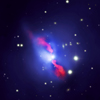CXC Home | Search | Help | Image Use Policy | Latest Images | Privacy | Accessibility | Glossary | Q&A
Tour of Hydra A
Quicktime MPEG
This composite image of the Hydra A galaxy cluster shows 10-million-degree gas observed by Chandra and jets of radio emission observed by the Very Large Array. The galaxies in the cluster are seen in optical light by two ground-based telescopes. At the center of Hydra A is a supermassive black hole that has experienced powerful outbursts. These outbursts pushed the material surrounding the black hole, creating giant cavities seen in the Chandra data. These cavities were then filled with material from jets seen in the radio data. The Chandra data reveal that the gas located along the direction of the radio jets is enhanced with iron and other metals. Scientists think that these elements, vital for stars, planets, and ultimately life, were forged in supernova explosions in the large galaxy at the center of the cluster.
[Runtime: 00:56]
Quicktime MPEG
This composite image of the Hydra A galaxy cluster shows 10-million-degree gas observed by Chandra and jets of radio emission observed by the Very Large Array. The galaxies in the cluster are seen in optical light by two ground-based telescopes. At the center of Hydra A is a supermassive black hole that has experienced powerful outbursts. These outbursts pushed the material surrounding the black hole, creating giant cavities seen in the Chandra data. These cavities were then filled with material from jets seen in the radio data. The Chandra data reveal that the gas located along the direction of the radio jets is enhanced with iron and other metals. Scientists think that these elements, vital for stars, planets, and ultimately life, were forged in supernova explosions in the large galaxy at the center of the cluster.
[Runtime: 00:56]
(Credit: X-ray: NASA/CXC/U.Waterloo/C.Kirkpatrick et al.; Radio: NSF/NRAO/VLA; Optical: Canada-France-Hawaii-Telescope/DSS)
Return to Hydra A (September 14, 2009)



